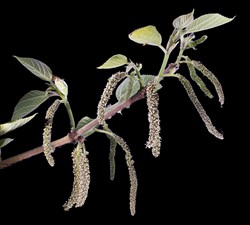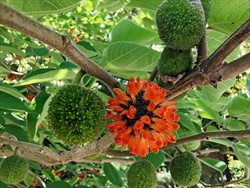Paper mulberry.
Pacific Pests, Pathogens, Weeds & Pesticides - Online edition
Pacific Pests, Pathogens, Weeds & Pesticides
Paper mulberry (542)
Broussonetia papyrifera. It was previously known as Morus papyrifera. A member of the Moraceae.
Asia, Africa, North, South, Central America, Europe, Oceania. It is recorded from Australia, Cook Islands, French Polynesia, Fiji, New Caledonia, New Zealand, Papua New Guinea, Samoa, Solomon Islands, Tonga, and Wallis & Futuna. Paper mulberry occurs naturally in Taiwan and Southeast Asia and was distributed by Lapita as far as Hawaii, Easter Island and New Zealand in Polynesian prehistory.
A fast-growing, highly invasive shrub or small tree naturalised across tropical, sub-tropical and warm temperate climates of East and Southeast Asia valued as a fine paper, and throughout Oceania for tapa cloth. It establishes thickets at the edges or in canopy gaps of forests, abandoned farmlands, and along roadsides. It is found from sea level to 1000 masl.
Trees to a height of 20 m. Trunks with latex, and greyish-brown, shallow grooved bark. Leaves, in spirals along the stem, 7-20 cm long, rough above and hairy below, variable in shape, entire and oval or deeply 3 to 5-lobed, especially on fast-growing young plants (Photos 1&2). Margins of the leaves have fine serrated edges. Leaf stalks, up to 8 cm. Male and female flower clusters are on separate trees. Individual male flowers are grouped (up to 200) in yellowish-white pendulous catkins, up to 8 cm long (Photo 3); female flower clusters are rounded, up to 2 cm diameter; individual flowers are long, thin and tube-like (Photo 4) with trailing long styles (extension of ovary). Fruits turn reddish when mature, seeds 1-2 cm long and wide.
Broussonetia papyrifera is insect and wind-pollinated, and seeds are dispersed by birds, bats and mammals. They may also be spread in water along creeks, rivers and in irrigation systems. Long distance spread with human migrations using cuttings from stems and root suckers. Once established, root suckering is prolific. More lately, spread internationally via seed sold via the Internet.
A weed with considerable potential to impact biodiversity because of its rapid rate of growth and ability to outcompete native species. It is especially water-demanding, taking the resource from its competitors. When the main stem is cut root suckers proliferate, and dense thickets form. It is difficult to manage.
Apart from its sticky sap, which can spoil clothes, its pollen has been the cause of serious allergies, and even deaths.
Introductions into Uganda, Ghana and Argentina, have resulted in it becoming invasive, as has its escape from cultivation on the Guadalcanal Plains of Solomon Islands. It is listed among the six worst plant invaders in Pakistan where it is recorded as impacting local vegetation.
Used traditionally throughout Asia (China, Japan, Korea, Myanmar, Thailand) as a source of fibre for high-quality paper, and in the Pacific as a source of cloth, having been introduced during Polynesian migrations. Additionally, it was used to make rope, and as a source of cheap wood for the manufacture of furniture, packing cases, matches, and pencils. It has been thought an ornamental, a shade tree, and, because of its fast growth, it has been used for stabilising soils where they are prone to erosion and slippage. It is also said to have medicinal uses.
BIOSECURITY
The chance of introduction of paper mulberry is probably low as it has been introduced already into many countries. However, climate change may provide new opportunities for spread, and in this regard its recent expansion into Europe should cause concern. Those countries not yet infested should consider all likely pathways for entry and apply quarantine measures accordingly. Particular attention should be given to the fact that seeds are readily available on the Internet.
An invasive plant risk assessment for Queensland, Australia, predicts that paper mulberry could become problematic in "riparian areas; semi-deciduous (closed) forests and vine thickets (especially margins and gaps); and disturbed, open sites generally, where there is relatively well-drained, moist, fertile soil. In these habitats, B. papyrifera could form dense thickets, perhaps replacing native vegetation and interfering with natural succession". It appears to be a 'high-risk' species and worthy of preventative control.
BIOLOGICAL CONTROL
Not a method recommended for Broussonetia papyrifera.
CULTURAL CONTROL
Physical & Mechanical:
- Hand-pulling (or uprooting by other methods) is possible for young, isolated plants or small plantings.
- ensure all stem fragments and roots are removed; collect and burn them, otherwise they may resprout if left on or in the soil
- Do not use topsoil from places where paper mulberry has been growing. It may contain stem and root pieces which will produce new shoots.
Regenerating forests (closing the gaps):
- In forests that are not heavily degraded, either: (i) leave the forest undisturbed, or (ii) add more seedlings/saplings of quick growing (native) species to shade out paper mulberry.
CHEMICAL CONTROL
Herbicides recommended for the control of African tulip tree (see Fact Sheet no. 436) are likely to be effective, but control of large infestations is likely to be very labour-intensive. Use the following: (i) triclopyr + picloram; (ii) triclopyr + picloram + aminopyralid, or (iii) glyphosate, and apply as follows:
- Cut stump/paint method:
- Cut trunks or stem just above ground level and paint immediately with undiluted herbicide.
- Cut, frill, drill method:
- Frill (chop off the bark, cut into the wood), then pour herbicide into the cuts. If herbicide is not applied, the roots will produce many new shoots.
--------------------
Note, EU approval to use glyphosate ended in December 2022, but has been extended by one year to 15 December 2023.
____________________
When using a pesticide, always wear protective clothing and follow the instructions on the product label, such as dosage, timing of application, and pre-harvest interval. Recommendations will vary with the crop and system of cultivation. Expert advice on the most appropriate herbicides to use should always be sought from local agricultural authorities.
AUTHOR Grahame Jackson
Information from Broussonetia papyrifera (Paper Mulbery). BioNET-EAFRINET. (https://keys.lucidcentral.org/keys/v3/eafrinet/weeds/key/weeds/Media/Html/Broussonetia_papyrifera_(Paper_Mulberry).htm); and CABI (2019) Broussonetia papyrifera (paper mulberry) Crop Protection Compendium. (https://www.cabidigitallibrary.org/doi/10.1079/cabicompendium.10017#sec-12); and Paper mulberry (Broussonetia papyrifera) (2021) NSW WeedWise. Department of Primary Industries; PlantNET (The NSW Plant Information Network System) (2020). Broussonetia papyrifera (L.) Vent. NSW Flora Online. Royal Botanic Gardens and Domain Trust, Sydney. (https://plantnet.rbgsyd.nsw.gov.au/cgi-bin/NSWfl.pl?page=nswfl&lvl=sp&name=Broussonetia~papyrifera). and Paper mulberry Broussetia papyrifera. Brisbane City Council Weed Identification Tool. (https://weeds.brisbane.qld.gov.au/weeds/paper-mulberry); and Paper mulberry (2022) Business Queensland, Queensland Government. (https://www.business.qld.gov.au/industries/farms-fishing-forestry/agriculture/biosecurity/plants/invasive/other/paper-mulberry); and Csurhes S (2016) Paper mulberry Broussonetia papyrifera. Invasive plant risk assessment. Department of Agriculture and Fisheries. Biosecurity Queensland. (https://www.daf.qld.gov.au/__data/assets/pdf_file/0011/67898/IPA-Paper-Mulberry-Risk-Assessment.pdf); and from Seelenfreunda D, et al. (2011) Paper mulberry (Broussonetia papyrifera) as a commensal model for human mobility in Oceania: anthropological, botanical and genetic considerations. New Zealand Journal of Botany 48(3): 1-17. (DOI: 10.1080/0028825X.2010.520323). Photo 1 Gerald McCormack, Cook Islands Biodiversity Database, Version 2007.2. Cook Islands Natural Heritage Trust, Rarotonga. (http://cookislands.bishopmuseum.org/). Photo 2 Didier Descouens (2009) Paper Mulberry (Broussonetia papyrifera). Leaves. France. (https://commons.wikimedia.org/wiki/File:Murier.jpg). Photo 3 Didier Descouens (2014) Paper Mulberry (Broussonetia papyrifera). Male flowering catkin. Fronton, France. (https://commons.wikimedia.org/wiki/File:Broussonetia_papyrifera_-_fleurs_m%C3%A2les.jpg). Photo 4 Didier Descouens (2019) Paper Mulberry (Broussonetia papyrifera). Fruits. Clemont-le-Fort, France. (https://commons.wikimedia.org/wiki/File:Broussonetia_papyrifera_fruits.jpg).
Produced with support from the Australian Centre for International Agricultural Research under project HORT/2016/185: Responding to emerging pest and disease threats to horticulture in the Pacific islands, implemented by the University of Queensland and the Secretariat of the Pacific.







